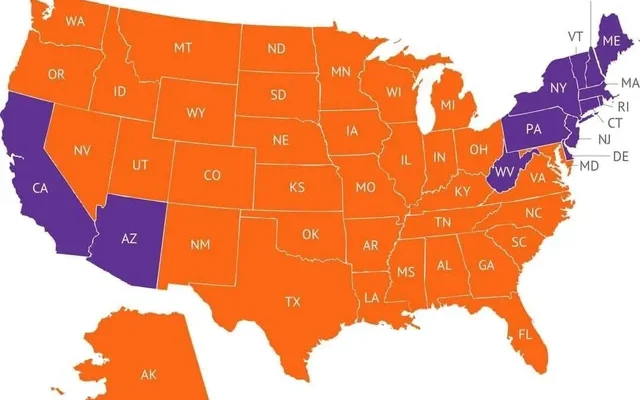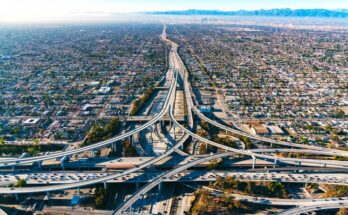This map shows a comparison between the number of prisons/jails and the number of colleges (institutions where you can earn a bachelor’s degree or above) in each state of the United States.

States are color-coded based on whether they have more prisons/jails (orange) or more colleges (purple).
Key insights from the map include:
- Orange States: These states have more prisons/jails than colleges. The majority of the states fall into this category, indicating that there are more prisons/jails than higher education institutions in most states across the country.
- Purple States: These states have more colleges than prisons/jails. These states include New York, California, Pennsylvania, Arizona, and several states in the Northeast region, such as Massachusetts, Rhode Island, and Connecticut.
Here is the full data set by State:
|
States
|
Colleges
|
Jail/Prisons
|
Difference
|
|---|---|---|---|
| Texas | 149 | 313 | -164 |
| Georgia | 69 | 217 | -148 |
| Alabama | 35 | 147 | -112 |
| Florida | 129 | 230 | -101 |
| Louisiana | 30 | 120 | -90 |
| Oklahoma | 31 | 117 | -86 |
| North Carolina | 73 | 157 | -84 |
| Mississippi | 18 | 92 | -74 |
| Kansas | 34 | 106 | -72 |
| Arkansas | 27 | 95 | -68 |
| Iowa | 38 | 105 | -67 |
| Missouri | 74 | 139 | -65 |
| Tennessee | 61 | 123 | -62 |
| Kentucky | 38 | 96 | -58 |
| Nebraska | 22 | 73 | -51 |
| Indiana | 60 | 110 | -50 |
| Wisconsin | 51 | 100 | -49 |
| Michigan | 61 | 108 | -47 |
| Minnesota | 51 | 92 | -41 |
| Colorado | 41 | 81 | -40 |
| Idaho | 13 | 46 | -33 |
| South Carolina | 42 | 71 | -29 |
| Montana | 14 | 42 | -28 |
| Virginia | 71 | 97 | -26 |
| Wyoming | 4 | 28 | -24 |
| New Mexico | 15 | 39 | -24 |
| Illinois | 98 | 120 | -22 |
| Alaska | 6 | 27 | -21 |
| Nevada | 16 | 36 | -20 |
| Oregon | 33 | 50 | -17 |
| South Dakota | 17 | 32 | -15 |
| Maryland | 35 | 49 | -14 |
| Ohio | 119 | 133 | -14 |
| North Dakota | 15 | 27 | -12 |
| Utah | 21 | 29 | -8 |
| Washington | 63 | 71 | -8 |
| Arizona | 36 | 36 | 0 |
| New Hampshire | 17 | 16 | 1 |
| Maine | 21 | 19 | 2 |
| Hawaii | 10 | 8 | 2 |
| Delaware | 6 | 4 | 2 |
| West Virginia | 27 | 24 | 3 |
| Rhode Island | 13 | 7 | 6 |
| Vermont | 15 | 8 | 7 |
| Connecticut | 27 | 14 | 13 |
| New Jersey | 63 | 28 | 35 |
| Pennsylvania | 134 | 97 | 37 |
| Massachusetts | 87 | 35 | 52 |
| New York | 236 | 116 | 120 |
| California | 280 | 147 | 133 |
You can find even more insights on studee including sources and methodology.
Why does the US have so many Prisons & Jails?
The United States has a high number of jails and prisons due to a combination of factors:
- High Incarceration Rates: The U.S. has one of the highest incarceration rates in the world. This is partly due to stringent law enforcement policies and a focus on punitive measures rather than rehabilitation.
- Tough on Crime Policies: Policies such as “three strikes” laws, mandatory minimum sentences, and the War on Drugs have contributed to longer sentences and higher incarceration rates for both violent and non-violent offenses.
- Drug Policies: The War on Drugs, initiated in the 1980s, led to a significant increase in the number of individuals incarcerated for drug-related offenses. Many of these offenses are non-violent, yet they carry heavy sentences.
- Private Prisons: The rise of private prisons has also contributed to the growth in the number of facilities. These prisons are profit-driven and have a financial incentive to house more inmates.
- Judicial Practices: Sentencing practices in the U.S. tend to be harsher compared to other countries. Judges often impose long sentences for a wide range of crimes, which leads to a higher prison population.
- Probation and Parole Violations: Many individuals are incarcerated for violations of probation or parole. These violations can be technical in nature (such as missing an appointment with a probation officer) rather than new criminal offenses.
- Mental Health and Substance Abuse Issues: A lack of adequate mental health and substance abuse treatment facilities means that many individuals with these issues end up in the criminal justice system rather than receiving appropriate care.
- Socioeconomic Factors: Poverty, lack of education, and limited access to employment opportunities can lead to higher crime rates, which in turn contribute to higher incarceration rates.
- Racial Disparities: Racial disparities in the criminal justice system result in higher incarceration rates for minority communities, particularly African Americans and Hispanics. These disparities are influenced by a variety of factors, including biased policing practices and sentencing disparities.
- Recidivism: High recidivism rates also contribute to the large prison population. Many individuals released from prison are rearrested and re-incarcerated due to a lack of support systems and opportunities for reintegration into society.
How do private prisons work?
Private prisons, also known as for-profit prisons, are operated by private, for-profit companies under contract with local, state, or federal government agencies. Here’s an overview of how they work:
1. Contractual Agreements
Private prison companies enter into contracts with government agencies. These contracts outline the terms and conditions under which the company will manage and operate the prison. The government pays the company a fee, usually based on the number of inmates housed.
2. Funding and Payment Structures
- Per Diem Payments: The government pays the private company a fixed amount per inmate per day. This payment covers all costs associated with housing, feeding, and providing healthcare for the inmates.
- Management Fees: Some contracts include additional management fees for overseeing the facility.
3. Construction and Ownership
- Build-to-Lease: In some cases, private companies build the prison facility and lease it back to the government.
- Build-to-Operate: In other instances, the private company both builds and operates the prison.
4. Operation and Management
Private prisons are responsible for all aspects of prison management, including:
- Security: Hiring and training correctional officers and other security personnel.
- Inmate Services: Providing healthcare, educational programs, vocational training, and recreational activities.
- Maintenance: Maintaining the physical infrastructure of the prison.
5. Regulatory Oversight
Government agencies monitor private prisons to ensure compliance with contractual obligations and standards. This includes regular inspections, audits, and evaluations to assess the quality of services and conditions within the facility.
6. Profit Motive
Private prison companies aim to generate profit by:
- Cost-Cutting: Reducing operational costs through measures such as lower staff salaries, fewer benefits, and minimal expenditures on inmate services.
- Increased Inmate Population: Profits increase with higher inmate populations, leading to potential conflicts of interest regarding incarceration policies.
7. Controversies and Criticisms
Private prisons face several criticisms, including:
- Cost Savings Debate: Some argue that cost savings are not as significant as claimed and that private prisons may cut corners, leading to lower quality care and security.
- Incentives for Incarceration: The profit motive may lead to lobbying for stricter sentencing laws and policies that increase incarceration rates.
- Quality of Care: Concerns about inadequate healthcare, education, and rehabilitation programs for inmates.
8. Legal and Ethical Concerns
Issues surrounding the privatization of prisons often involve ethical questions about the commodification of incarceration and the potential impact on inmates’ rights and welfare.



